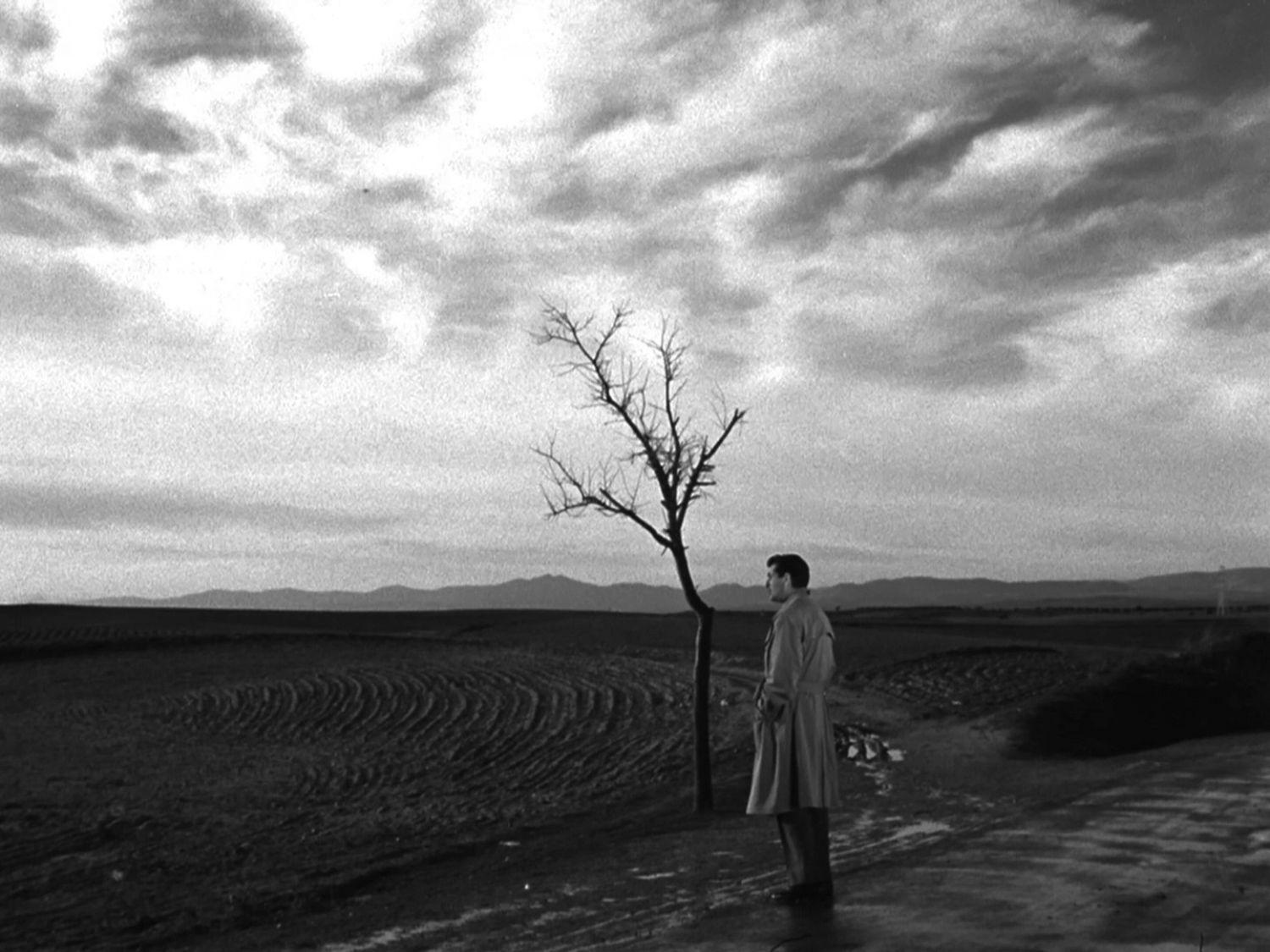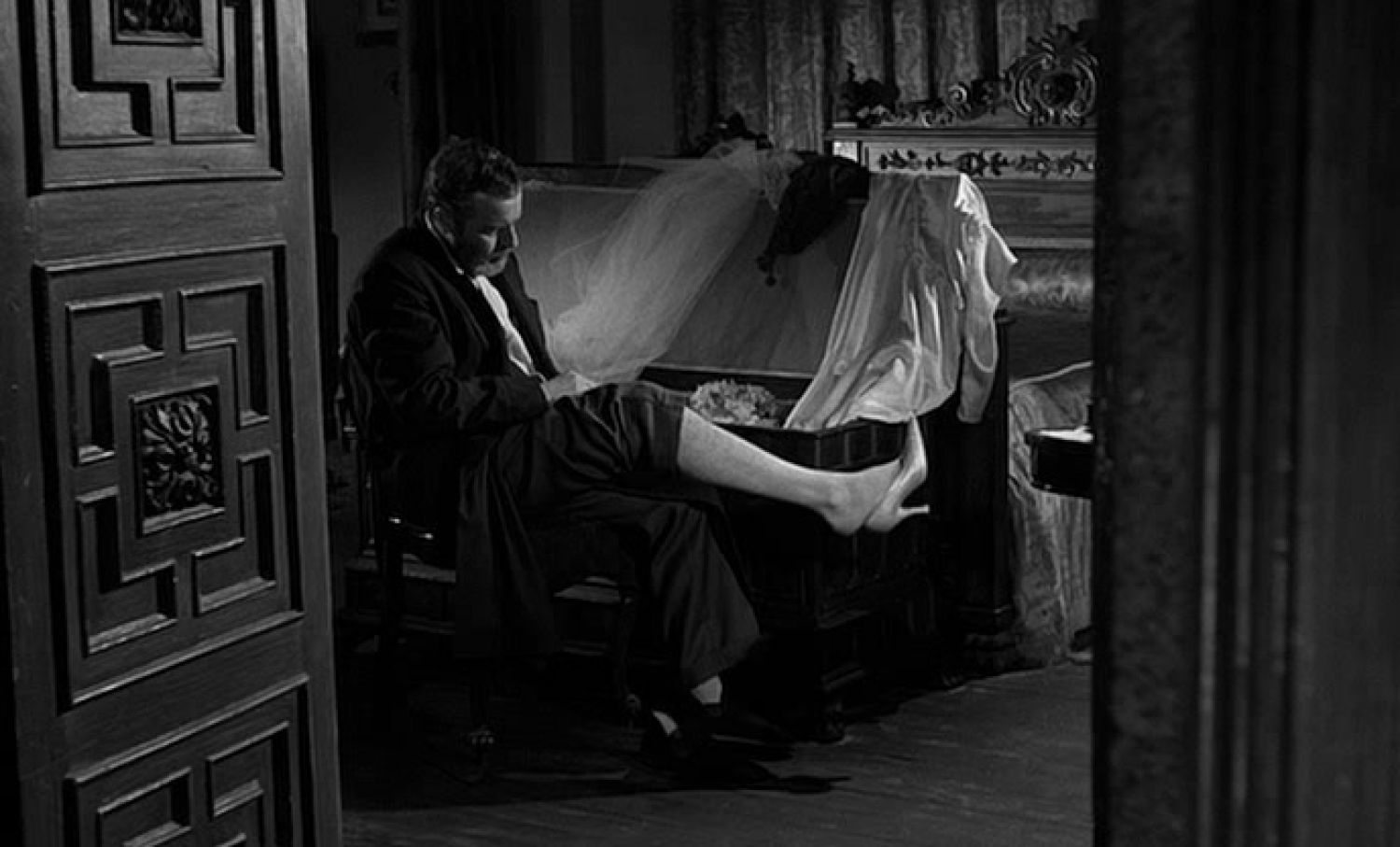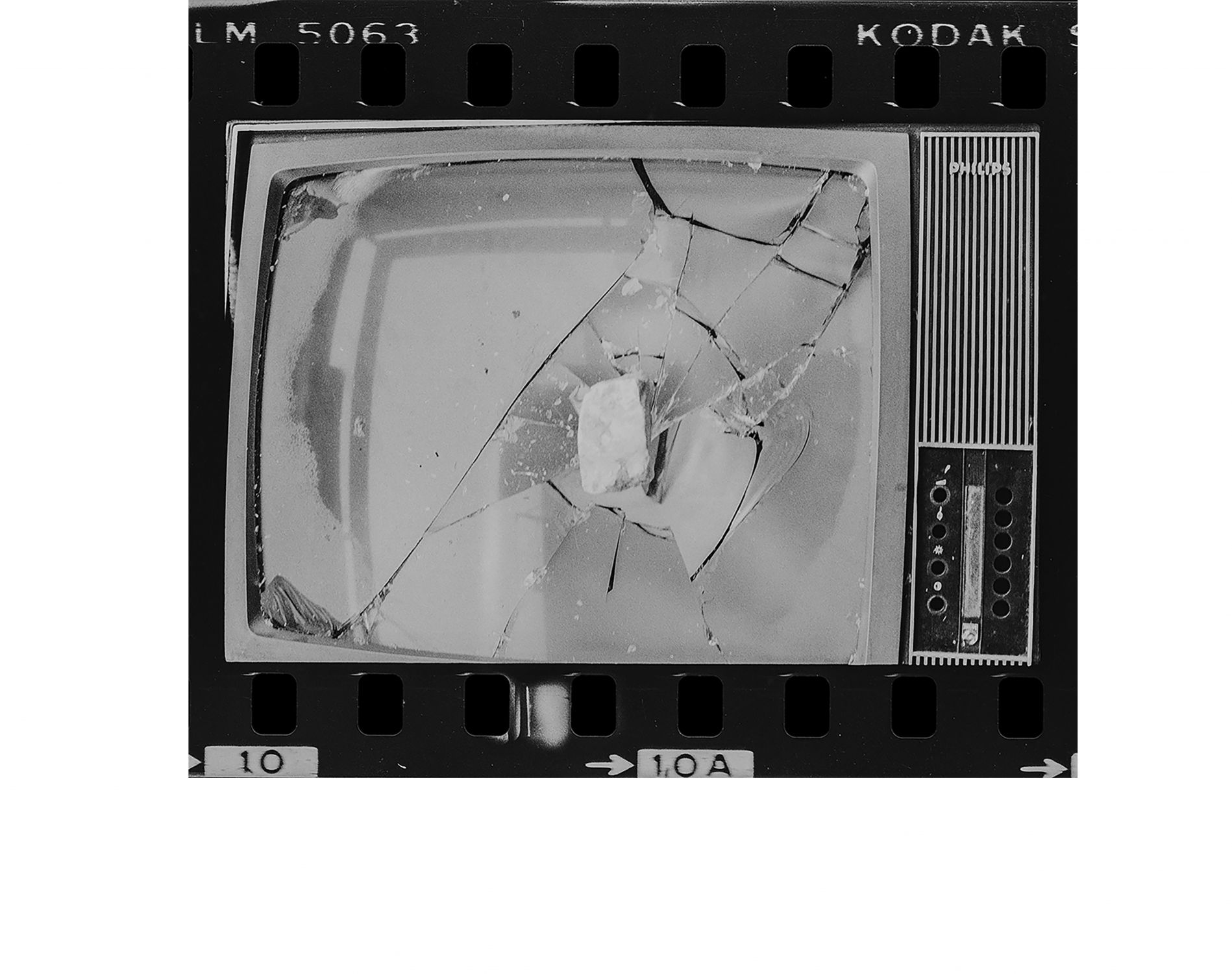A candle for God and another for the Devil
Carlos Alberto Carrilho
«(...) the historic Salida de la misa de doce del Pilar de Zaragoza (Worshippers leaving the noon mass at Pilar de Zaragoza) bears the great significance of marking the indisputable beginning of Spanish cinematography, furthermore doing it not with the arrivals and departures of trains that initiate film production almost everywhere else in the world, but laying down in celluloid a testimonial of the national sensibility, religious faith, and doing so precisely in the temple that is justly called Sanctuary of Race.» (Carlos Fernández Cuenca, 1959[1])
Images of the Cinema in Francoist Spain
Maybe Salida de la misa de doce de la Iglesia del Pilar de Zaragoza (Eduardo Jimeno Correas, 1897) was not the first film of Spanish cinematography as there are controversies and accusations that sectors linked to Franco’s dictatorship have manipulated History and created the myth because of ideological reasons. Still, if we compare the scenarios chosen for this film and Sortie des Usines Lumière (Lumière Brothers, 1895), a founding moment of the film production in France, respectively the church and the factory, one can understand the different hierarchical significance that was given to the practices of religion and work in each society, the first of which remained primarily agrarian, while the second experienced broad industrial development. Regarding Spain, early cinema was seen as a powerful machine able to summon all the evils denounced by the ruling powers, from the proximity between bodies that was favoured by the darkness of the movie theatre to the messages emanated by the screen. This perspective accompanied the diffusion of cinema throughout the country, which was reorganized upon the introduction of the «talkies», and which the dictatorship of General Francisco Franco converted into a medium of censorship, intended to dominate the population over several decades, first by forcing scripts to be submitted for analysis and then by demanding the same procedure for finalized films and promotional material. Among other measures, and even before Franco’s rise to power in 1921, it was decreed that Madrilenian cinemas were to be divided into three spaces: one for ladies, one for gentlemen and a third one, lit by red light, for couples, in case the devil were to poison the spirits and hinder the bodies. In 1937, during the Civil War, cinema was regarded as a vehicle of propaganda on both sides of the trenches. That led Francoists to create the Superior Board of Film Censorship, shortly after the Republicans had implemented censorship regulations in the territories under their rule.

The rise to power of Franco’s dictatorship, which ruled from 1939 to 1976, was the ideal occasion for the regime to confirm the ideological possibilities of cinema as an influential vehicle «in the dissemination of ideas and education of the masses». State supervision was vital to guarantee the integrity of its guiding principles: nationalism, Catholicism and anti-communism. Cinema was one of the passions of Francisco Franco, who in addition to personally taking part in censorship over produced films, also wrote the script of one of the main ideological flags of the regime, the film Raza (José Luis Sáenz de Heredia, 1942), under the pseudonym «Jaime de Andrade». While some films and authors were close to Francisco Franco’s ideas, many of the relevant artists stood on opposite ideological fields, much to the dictator’s dismay. Thus, during the Civil War, and later during Francoism, many artists sought exile in other countries, including the influential Pablo Picasso and Luis Buñuel, while others remained in an «internal exile», continuing their creative practices in Spain, where they were forced to coexist with fascist cultural circles, while translating their own ideological views into works that subtly circumvented censorship rules. The obligatory dubbing of foreign films in Spanish created new opportunities for censorship control. In Mogambo (John Ford, 1953), for instance, Grace Kelly became the sister of Donald Sinden, her husband in the original version, so that she could give in to Clark Gable’s charms.
It was in this restrictive context that, in the 1950s, the grammar of post-dictatorship cinema started to emerge in the lavish works of Luis García Berlanga (Bienvenido Mister Marshall, Placido, El verdugo), Juan Antonio Bardem (Muerte de un ciclista, Calle Mayor), Víctor Erice (El espíritu de la colmena), Carlos Saura (Los golfos, La caza), Basilio Martín Patino (Nueve cartas a Berta, Canciones para después de una guerra), Fernando Fernán Gómez (El extraño viaje), Miguel Picazo (La tía Tula) and José Luis Borau (Furtivos). Several of these filmmakers were educated at the new Instituto de Investigaciones y Experiencias Cinematográficas (Institute for Cinematic Research and Experiments, created in 1947) and promoted the Salamanca Conversations (1955), also known as The First Talks on Spanish Cinema. These talks were transformed into a manifesto by the new authors, who were inspired by the challenges of Italian neo-realism and proposed new forms and themes to respond to the conflicts and hopes that pervaded Spanish society, in opposition to the generations of older filmmakers, who weren’t interested in breaking the dictates of censorship and whose production appropriated local folklore in order to promote literary adaptations and historical dramas. Juan Antonio Bardem concluded the discussion with these words: «Spanish cinema is: politically ineffective, socially false, intellectually insignificant, aesthetically null and industrially rickety».
Surcos (1951) by José Antonio Nieves Conde, an older filmmaker who supported the regime but who was by then disillusioned with a social revolution long overdue, was the exception appreciated by the «young turks», because it exhibited signs of the necessary winds of change. In this moral tale, in which the phenomenon of mass rural migration to urban centres is mixed with a gangster story, a family is faced with the harsh hidden realities of the city (family breakdown, crowded residential ghettos, poverty, prostitution and delinquency). The film ends with a nostalgic return to the village, which reassembles whatever is left of the family nucleus: a conclusion entirely fitting to Franco’s expectations. In two delightful scenes that deride the taste of the regime and the tone of the film itself, a protégée of the gang leader suggests that they should go to the movies to watch a «psychological film», to which he replies that that is a thing of the past, that the new thing is neo-realism. The bored woman tries to guess what she is to expect from that kind of movie, and spitefully wonders if it is about social problems and slums. On the way home after the screening, she regrets that the audience gets excited about the display of such misery on screen, since she finds watching the daily life of the rich to be much more exciting. The contradictions raised by the film were mirrored by the contradictions and arbitrariness of the censorship system itself, well illustrated by the scandal that broke when the Catholic Church denounced the film’s raw and amoral content, while at the same time the film was awarded the official title of «National Interest», over a historical drama much to the taste of the regime.

The Salamanca Conversations were an important step in the creation of the New Spanish Cinema, as they brought to light everything that Franco had crossed out of his depiction of the country: the wounds of the Civil War, which was then simply referred to as the «war», so that an audience unfamiliar with Spanish history would think that it meant one of the two World Wars; the suffocating atmosphere orchestrated by the repressive regime represented by characters cloistered indoors, by barriers where even glass seemed unbreakable, and which came to a dry end with the sudden introduction of the ending credits, which averted the audience’s tears; migration to the cities and consequent precarious living conditions; the social position of women; the suffocating presence of the Catholic Church, with the recurrence of scenes with priests, which sometimes appeared just as extras; homosexuality; transsexuality; adultery; teenage pregnancy; prostitution; or crime. One of the devices that censors seemed to tolerate consisted in relocating problematic narratives beyond Spanish borders, as well as in giving the parts which included «illegal» actions to foreign actors: in the first shots of Calle Mayor (1956), a voice-off announces that «the story about to begin has no precise geographical coordinates and the colour of the sky, the shape of the houses, the ads on the walls or a certain way of speaking and smiling should not belong to any specific flag»; the first image of a woman in a bikini ever to be produced by Spanish cinema starred the Swedish actress Elke Sommer in Bahía de Palma (Juan Bosch, 1962). Paradoxically, while the New Spanish Cinema troubled political powers internally, it received accolades at major international film festivals (Cannes, Venice and Berlin), a fact that conveyed an image of modernity to external countries, and which the ruling powers boasted in order to counter the international isolation that the dictatorial status had imposed upon the country.
In the 1960s and 1970s, the production of horror movies also experienced rapid development, in line with what was happening in other European countries such as the UK, Italy, France or Germany, thereby facilitating co-production funding and international distribution. Since greater freedom of habits was experienced across Europe, particularly in what concerned the representation of sex and violence, soon works such as – Jess Franco (Gritos en la noche, Miss Muerte, Eugenie, Vampyros Lesbos) Narciso Ibáñez Serrador (La Residencia, ¿Quién puede matar a un niño?), Amando de Ossorio (Templarios Ciegos tetralogy), Eloy de la Iglesia (La Semana del asesino) and dozens of films interpreted by Paul Naschy – began feeding the «exploitation» circuits of major international cities. Several versions with different titles were produced, each of them severed of all items prohibited by the target country’s censorship. Not surprisingly, the Spanish versions were usually the most restrained. Jess Franco, an international cult author, started to shoot outside of Spain, particularly in Portugal, where he created dozens of soft-core and hard-core films, sometimes alongside local producers, technical personnel and actors (including the producer Interfilme and the little-known but beautiful actress Britt Nichols). In one of his last interviews, while discussing Christina, princesse de l’érotisme (A Virgin Among the Living Dead, 1971), which was shot in palaces, stately homes and gardens in the Sintra area, Jess Franco mentioned how surprised he was by the permissive atmosphere he had always experienced in Portugal, a country that lived also under a dictatorship, citing as an example the cooperation of Portuguese authorities, who sent police officers to ensure safety, even while erotic scenes were being filmed in public places. What can be explained by a misunderstanding created by the director to have the same last name of the Spanish dictator or perhaps greater openness provided by the marcelista regime.
In addition to the Madrid group associated with the New Spanish Cinema, the so-called «Barcelona School» emerged. Despite what the name might suggest, it was not an organized association, but rather a group of filmmakers, some of whom with no academic training, who moved among the Catalan bourgeoisie and shared aesthetic and formal concerns. Pere Portabella and Vicente Aranda were some of the group’s most prominent names. The work of Portabella is relevant because it traverses several facets of Spanish cinema and displays an array of ways of dealing with the censorship. He began his career as producer of Los golfos (Carlos Saura, 1960), Viridiana (Luis Buñuel, 1961) and El cochecito (Marco Ferreri, 1960), all of which are emblematic examples of the new cinematic gaze proposed by the New Spanish Cinema. While living in Mexico as a refugee after the Civil War, Buñuel was invited to return to Spain to shoot Viridiana, a film which, with recourse to a number of different devices, managed to become a huge crater within the strict limits imposed by the censorship: the sinful gaze at the legs of a child jumping rope; the fetish obsession of an uncle who performs rituals wearing the clothes that his deceased bride had worn on their wedding night; the «saintly» Viridiana who is drugged and made to wear the dead bride’s clothes in order to be sexually abused by her uncle and forced to renounce her nun’s vows; the poor people who Viridiana protects and who, in her absence, organize an orgy-feast where they imitate Christ and the Apostles to compose a picture modelled after Leonardo da Vinci’s Last Supper; or the sexual abuse of Viridiana by the very people to whom she had given shelter. Censors intervened and requested that Buñuel changed the ending: Viridiana were to enter the house and shut the door, remaining alone with her cousin. Alternatively, Buñuel’s new proposal was accepted: Viridiana enters the house, where she finds her cousin with the maid with whom he is sexually involved, who invites both women for a game of cards, thus hinting at the idea of a «threesome». Only the scandal provoked by the film’s exhibition at the Cannes Film Festival lead the authorities to finally disown the film and to eliminate it for many years from the records of films produced in Spain.

In 1969, Pere Portabella closely followed the shooting of El Conde Drácula (Jess Franco) in Barcelona, an adaptation intended to be faithful to Bram Stoker’s book Dracula (1897). It has been noted, however, that it might have been Jess Franco’s intention to equate Dracula with the dictator Francisco Franco – the fact that the director and the dictator share the same surname is just a plain coincidence. Pere Portabella’s work resulted in the remarkable film Vampir-Cuadecuc, where he used high contrast black and white film to create expressionist images that reveal the backstage, the creation of environments, the artificial production of fog and cobwebs, pauses, repetitions and the smiles of the actors facing the camera, therefore exposing the codes that define the horror genre and exploring the language of cinema. The dialogues were replaced by silence, as well as by the concrete music composed by Carles Santos, which put the sound of musical instruments together with recognizable noises of everyday life, which interfered unusually with the visual contents and helped create disturbing situations, such as the scenes in which the actors speak but only the sound of what seems to be insistent knocking at a door or floor is heard. However, what sets Cuadecuc apart from a mere making-of is the fact that Portabella (re)shot Jess Franco’s scenes as if they were his own, capturing them from different angles, therefore not only «vampirizing» the original director’s work, but also portraying scenes of Francoist Spain stuck in time, with its deserted streets and seemingly vacant buildings, which contrasted with images or fading off-sounds that suggested movement, change or progress: a scene shot from a fast moving vehicle is played until it disintegrates into abstraction, a train goes by so fast that we can only retain the lines of the carriages’ design or the sounds of an airplane and of a jackhammer that drills the ground. Dracula impose his reign of terror from the balcony of his palace, carefully watching over every movement. Pere Portabella does not show the death of Dracula on screen. Instead, he asks Christopher Lee, who plays Dracula, to remove all the elements of his mask and to read the excerpt of Bram Stoker’s book that describes that moment, ending the film with a close-up of the actor’s face, who remains still for a few seconds looking into the camera, until a shout is heard: cut. It is the end of the film and the manifestation of the will to overthrow the oppressive regime, a desire that would become reality a few years later, in 1975, with the dictator’s death.
–
Acknowledgements: Sabrina D. Marques, Filipa Cordeiro, Rita Gomes Ferrão
Footnotes
- ^ Carlos Fernández Cuenca. (1959). Promio, Jimeno y los primeros pasos del cine en España. Madrid: Filmoteca Nacional de España.




